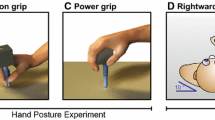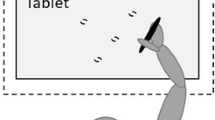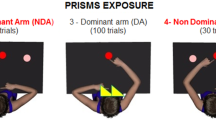Abstract
To date, interlimb transfer following visuomotor adaptation has been mainly investigated through discrete reaching movements. Here we explored this issue in the context of continuous manual tracking, a task in which the contribution of online feedback mechanisms is crucial, and in which there is a well-established right (dominant) hand advantage under baseline conditions. We had two objectives (1) to determine whether this preexisting hand asymmetry would persist under visuomotor rotation, (2) to examine interlimb transfer by assessing whether prior experience with the rotation by one hand benefit to the other hand. To address these, 44 right-handed participants were asked to move a joystick and to track a visual target following a rather unpredictable trajectory. Visuomotor adaptation was elicited by introducing a 90° rotation between the joystick motion and the cursor motion. Half of the participants adapted to the rotation first with the right hand, and then with the left, while the other half performed the opposite protocol. As expected during baseline trials, the left hand was less accurate while also exhibiting more variable and exploratory behavior. However, participants exhibited a left hand advantage during first exposure to the rotation. Moreover, interlimb transfer was observed albeit more strongly from the left to the right hand. We suggest that the less effective and more variable/exploratory control strategy of the left hand promoted its adaptation, which incidentally favored transfer from left to right hand. Altogether, this study speaks for further attention to the dominant/non-dominant asymmetry during baseline before examining interlimb transfer of adaptation.







Similar content being viewed by others
Data availability
Data that support the findings of this study will be made available upon reasonable request.
References
Abeele, S., & Bock, O. (2001). Mechanisms for sensorimotor adaptation to rotated visual input. Experimental Brain Research, 139(2), 248–253. https://doi.org/10.1007/s002210100768
Abeele, S., & Bock, O. (2003). Transfer of sensorimotor adaptation between different movement categories. Experimental Brain Research, 148(1), 128–132. https://doi.org/10.1007/s00221-002-1317-0
Aoki, T., Niu, X., Latash, M. L., & Zatsiorsky, V. M. (2006). Effects of friction at the digit-object interface on the digit forces in multi-finger prehension. Experimental Brain Research, 172(4), 425–438. https://doi.org/10.1007/s00221-006-0350-9
Aoki, T., Rivlis, G., & Schieber, M. H. (2016). Handedness and index finger movements performed on a small touchscreen. Journal of Neurophysiology, 115(2), 858–867. https://doi.org/10.1152/jn.00256.2015
Apolinário-Souza, T., Lage, G., & Fernandes, L. (2023). Hand differences in aiming task : A complementary spatial approach. Preprint available at: https://www.researchgate.net/publication/371307324_Hand_differences_in_aiming_task_a_complementary_spatial_approach#fullTextFileContent. Accessed June 2023
Bagesteiro, L. B., & Sainburg, R. L. (2002). Handedness: dominant arm advantages in control of limb dynamics. Journal of Neurophysiology, 88(5), 2408–2421. https://doi.org/10.1152/jn.00901.2001
Balitsky Thompson, A. K., & Henriques, D. Y. P. (2010). Visuomotor adaptation and intermanual transfer under different viewing conditions. Experimental Brain Research, 202(3), 543–552. https://doi.org/10.1007/s00221-010-2155-0
Carey, D. P., & Liddle, J. (2013). Hemifield or hemispace: What accounts for the ipsilateral advantages in visually guided aiming? Experimental Brain Research, 230(3), 323–331. https://doi.org/10.1007/s00221-013-3657-3
Carey, J. R., Comnick, K. T., Lojovich, J. M., & Lindgren, B. R. (2003). Left- versus right-hand tracking performance by right-handed boys and girls: Examination of performance asymmetry. Perceptual and Motor Skills, 97(3 Pt 1), 779–788. https://doi.org/10.2466/pms.2003.97.3.779
Carroll, T. J., Poh, E., & de Rugy, A. (2014). New visuomotor maps are immediately available to the opposite limb. Journal of Neurophysiology, 111(11), 2232–2243. https://doi.org/10.1152/jn.00042.2014
Carson, R. G. (1993). Manual asymmetries: old problems and new directions. Human Movement Science, 12(5), 479–506.
Chase, C., & Seidler, R. (2008). Degree of handedness affects intermanual transfer of skill learning. Experimental Brain Research, 190(3), 317–328. https://doi.org/10.1007/s00221-008-1472-z
Cho, J., Park, K.-S., Kim, M., & Park, S.-H. (2006). Handedness and asymmetry of motor skill learning in right-handers. Journal of Clinical Neurology, 2(2), 113. https://doi.org/10.3988/jcn.2006.2.2.113
Cohen, E. J., Wei, K., & Minciacchi, D. (2019). Visuomotor perturbation in a continuous circle tracing task: novel approach for quantifying motor adaptation. Scientific Reports, 9(1), 18679. https://doi.org/10.1038/s41598-019-55241-4
Coudiere, A., Fernandez, E., de Rugy, A., & Danion, F. R. (2022). Asymmetrical transfer of adaptation between reaching and tracking: Implications for feedforward and feedback processes. Journal of Neurophysiology, 128(3), 480–493. https://doi.org/10.1152/jn.00547.2021
Dhawale, A. K., Smith, M. A., & Ölveczky, B. P. (2017). The role of variability in motor learning. Annual Review of Neuroscience, 40, 479–498. https://doi.org/10.1146/annurev-neuro-072116-031548
Elliott, D., Heath, M., Binsted, G., Ricker, K. L., Roy, E. A., & Chua, R. (1999). Goal-directed aiming: correcting a force-specification error with the right and left hands. Journal of Motor Behavior, 31(4), 309–324. https://doi.org/10.1080/00222899909600997
Elliott, D., Roy, E. A., Goodman, D., Carson, R. G., Chua, R., & Maraj, B. K. V. (1993). Asymmetries in the preparation and control of manual aiming movements. Canadian Journal of Experimental Psychology/revue Canadienne De Psychologie Expérimentale, 47(3), 570–589. https://doi.org/10.1037/h0078856
Flowers, K. (1975). Handedness and controlled movement. British Journal of Psychology, 66(1), 39–52. https://doi.org/10.1111/j.2044-8295.1975.tb01438.x
Freeman, G. L., & Chapman, J. S. (1935). The relative importance of eye and hand dominance in a pursuit skill. The American Journal of Psychology, 47(1), 146–149. https://doi.org/10.2307/1416715
Freitas, S. M. S. F., & Scholz, J. P. (2009). Does hand dominance affect the use of motor abundance when reaching to uncertain targets? Human Movement Science, 28(2), 169–190. https://doi.org/10.1016/j.humov.2009.01.003
Garry, M. I., Kamen, G., & Nordstrom, M. A. (2004). Hemispheric differences in the relationship between corticomotor excitability changes following a fine-motor task and motor learning. Journal of Neurophysiology, 91(4), 1570–1578. https://doi.org/10.1152/jn.00595.2003
Goble, D. J., & Brown, S. H. (2008). Upper limb asymmetries in the matching of proprioceptive versus visual targets. Journal of Neurophysiology, 99(6), 3063–3074. https://doi.org/10.1152/jn.90259.2008
Gouirand, N., Mathew, J., Brenner, E., & Danion, F. (2019). Eye movements do not play an important role in the adaptation of hand tracking to a visuomotor rotation. Journal of Neurophysiology. https://doi.org/10.1152/jn.00814.2018
Harris, C. S. (1963). Adaptation to displaced vision: visual motor or proprioceptive change? Science, 140, 812–813.
He, K., Liang, Y., Abdollahi, F., Bittmann, M. F., Kording, K., & Wei, K. (2016). The statistical determinants of the speed of motor learning. PLOS Computational Biology, 12(9), e1005023. https://doi.org/10.1371/journal.pcbi.1005023
Henriques, D. Y. P., & Cressman, E. K. (2012). Visuomotor adaptation and proprioceptive recalibration. Journal of Motor Behavior, 44(6), 435–444. https://doi.org/10.1080/00222895.2012.659232
Ikegami, T., Hirashima, M., Taga, G., & Nozaki, D. (2010). Asymmetric transfer of visuomotor learning between discrete and rhythmic movements. The Journal of Neuroscience: THe Official Journal of the Society for Neuroscience, 30(12), 4515–4521. https://doi.org/10.1523/JNEUROSCI.3066-09.2010
Imamizu, H., & Shimojo, S. (1995). The locus of visual-motor learning at the task or manipulator level : Implications from intermanual transfer. Journal of Experimental Psychology. Human Perception and Performance, 21(4), 719–733.
Kirby, K. M., Pillai, S. R., Carmichael, O. T., & Van Gemmert, A. W. A. (2019). Brain functional differences in visuo-motor task adaptation between dominant and non-dominant hand training. Experimental Brain Research, 237(12), 3109–3121. https://doi.org/10.1007/s00221-019-05653-5
Kitazawa, S., Kimura, T., & Uka, T. (1997). Prism adaptation of reaching movements: specificity for the velocity of reaching. Journal of Neuroscience, 17(4), 1481–1492. https://doi.org/10.1523/JNEUROSCI.17-04-01481.1997
Krakauer, J. W. (2009). Motor learning and consolidation: the case of visuomotor rotation. Advances in Experimental Medicine and Biology, 629, 405–421. https://doi.org/10.1007/978-0-387-77064-2_21
Krakauer, J. W., Pine, Z. M., Ghilardi, M. F., & Ghez, C. (2000). Learning of visuomotor transformations for vectorial planning of reaching trajectories. The Journal of Neuroscience: THe Official Journal of the Society for Neuroscience, 20(23), 8916–8924.
Kumar, A., Panthi, G., Divakar, R., & Mutha, P. K. (2020). Mechanistic determinants of effector-independent motor memory encoding. Proceedings of the National Academy of Sciences, 117(29), 17338–17347. https://doi.org/10.1073/pnas.2001179117
Lam, S.-Y., & Zénon, A. (2021). Information Rate in humans during visuomotor tracking. Entropy, 23(2), 228. https://doi.org/10.3390/e23020228
Latash, M. L. (1999). Mirror writing: Learning, transfer, and implications for internal inverse models. Journal of Motor Behavior, 31(2), 107–111. https://doi.org/10.1080/00222899909600981
Lefumat, H. Z., Vercher, J.-L., Miall, R. C., Cole, J., Buloup, F., Bringoux, L., Bourdin, C., & Sarlegna, F. R. (2015). To transfer or not to transfer? Kinematics and laterality quotient predict interlimb transfer of motor learning. Journal of Neurophysiology, 114(5), 2764–2774. https://doi.org/10.1152/jn.00749.2015
Martin, T. A., Keating, J. G., Goodkin, H. P., Bastian, A. J., & Thach, W. T. (1996). Throwing while looking through prismsII. Specificity and storage of multiple gaze—Throw calibrations. Brain, 119(4), 1199–1211. https://doi.org/10.1093/brain/119.4.1199
Mathew, J., Bernier, P.-M., & Danion, F. R. (2018). Asymmetrical relationship between prediction and control during visuomotor adaptation. Eneuro. https://doi.org/10.1523/ENEURO.0280-18.2018
Mathew, J., de Rugy, A., & Danion, F. R. (2020). How optimal is bimanual tracking? The key role of hand coordination in space. Journal of Neurophysiology, 123(2), 511–521. https://doi.org/10.1152/jn.00119.2019
Mathew, J., Sarlegna, F. R., Bernier, P.-M., & Danion, F. R. (2019). Handedness matters for motor control but not for prediction. eNeuro. https://doi.org/10.1523/ENEURO.0136-19.2019
McGrath, R. L., & Kantak, S. S. (2016). Reduced asymmetry in motor skill learning in left-handed compared to right-handed individuals. Human Movement Science, 45, 130–141. https://doi.org/10.1016/j.humov.2015.11.012
Mrotek, L. A., & Soechting, J. F. (2007). Target interception: hand-eye coordination and strategies. The Journal of Neuroscience, 27(27), 7297–7309. https://doi.org/10.1523/JNEUROSCI.2046-07.2007
Noguchi, T., Demura, S., Nagasawa, Y., & Uchiyama, M. (2005). The practice effect and its difference of the pursuit rotor test with the dominant and non-dominant hands. Journal of Physiological Anthropology and Applied Human Science, 24(6), 589–593. https://doi.org/10.2114/jpa.24.589
O’Sullivan, I., Burdet, E., & Diedrichsen, J. (2009). Dissociating variability and effort as determinants of coordination. PLoS Computational Biology, 5(4), e1000345. https://doi.org/10.1371/journal.pcbi.1000345
Ogawa, K., & Imamizu, H. (2013). Human sensorimotor cortex represents conflicting visuomotor mappings. The Journal of Neuroscience, 33(15), 6412–6422. https://doi.org/10.1523/JNEUROSCI.4661-12.2013
Oldfield, R. C. (1971). The assessment and analysis of handedness: the Edinburgh inventory. Neuropsychologia, 9(1), 97–113.
Parlow, S. E., & Kinsbourne, M. (1989). Asymmetrical transfer of training between hands: implications for interhemispheric communication in normal brain. Brain and Cognition, 11(1), 98–113. https://doi.org/10.1016/0278-2626(89)90008-0
Peña-Pérez, N., Eden, J., Ivanova, E., Farkhatdinov, I., & Burdet, E. (2023). How virtual and mechanical coupling impact bimanual tracking. Journal of Neurophysiology, 129(1), 102–114. https://doi.org/10.1152/jn.00057.2022
Perelle, I. B., Ehrman, L., & Manowitz, J. W. (1981). Human handedness: the influence of learning. Perceptual and Motor Skills, 53(3), 967–977. https://doi.org/10.2466/pms.1981.53.3.967
Poh, E., Carroll, T. J., & Taylor, J. A. (2016). Effect of coordinate frame compatibility on the transfer of implicit and explicit learning across limbs. Journal of Neurophysiology, 116(3), 1239–1249. https://doi.org/10.1152/jn.00410.2016
Renault, A. G., Lefumat, H., Miall, R. C., Bringoux, L., Bourdin, C., Vercher, J.-L., & Sarlegna, F. R. (2020). Individual movement features during prism adaptation correlate with after-effects and interlimb transfer. Psychological Research Psychologische Forschung, 84(4), 866–880. https://doi.org/10.1007/s00426-018-1110-8
Reuter, E.-M., Cunnington, R., Mattingley, J. B., Riek, S., & Carroll, T. J. (2016). Feedforward compensation for novel dynamics depends on force field orientation but is similar for the left and right arms. Journal of Neurophysiology, 116(5), 2260–2271. https://doi.org/10.1152/jn.00425.2016
Roy, E. A., & Elliott, D. (1986). Manual asymmetries in visually directed aiming. Canadian Journal of Psychology, 40(2), 109–121.
Roy, E. A., & Elliott, D. (1989). Manual asymmetries in aimed movements. The Quarterly Journal of Experimental Psychology Section A, 41(3), 501–516. https://doi.org/10.1080/14640748908402379
Sainburg, R. L. (2002). Evidence for a dynamic-dominance hypothesis of handedness. Experimental brain research. Experimentelle Hirnforschung. Expérimentation Cérébrale, 142(2), 241–258. https://doi.org/10.1007/s00221-001-0913-8
Sainburg, R. L. (2005). Handedness: differential specializations for control of trajectory and position. Exercise and Sport Sciences Reviews, 33(4), 206–213.
Sainburg, R. L., & Kalakanis, D. (2000). Differences in control of limb dynamics during dominant and nondominant arm reaching. Journal of Neurophysiology, 83(5), 2661–2675. https://doi.org/10.1152/jn.2000.83.5.2661
Sainburg, R. L., & Wang, J. (2002). Interlimb transfer of visuomotor rotations: independence of direction and final position information. Experimental Brain Research, 145(4), 437–447. https://doi.org/10.1007/s00221-002-1140-7
Salimpour, Y., & Shadmehr, R. (2014). Motor costs and the coordination of the two arms. The Journal of Neuroscience: THe Official Journal of the Society for Neuroscience, 34(5), 1806–1818. https://doi.org/10.1523/JNEUROSCI.3095-13.2014
Schabowsky, C. N., Hidler, J. M., & Lum, P. S. (2007). Greater reliance on impedance control in the nondominant arm compared with the dominant arm when adapting to a novel dynamic environment. Experimental Brain Research, 182(4), 567–577. https://doi.org/10.1007/s00221-007-1017-x
Schaffer, J. E., & Sainburg, R. L. (2017). Interlimb differences in coordination of unsupported reaching movements. Neuroscience, 350, 54–64. https://doi.org/10.1016/j.neuroscience.2017.03.025
Schulze, K., Lüders, E., & Jäncke, L. (2002). Intermanual transfer in a simple motor task. Cortex, 38(5), 805–815. https://doi.org/10.1016/S0010-9452(08)70047-9
Seidler, R. D. (2006). Differential effects of age on sequence learning and sensorimotor adaptation. Brain Research Bulletin, 70(4), 337–346. https://doi.org/10.1016/j.brainresbull.2006.06.008
Simon, J. R., Crow, T. W. D., Lincoln, R. S., & Smith, K. U. (1952). Effects of handedness on tracking accuracy. Motor Skills Research Exchange, 4(3), 53–57. https://doi.org/10.2466/pms.1952.4.3.53
Snyder, K., Cormack, L., & Hayhoe, M. (2014). Visuomotor adaptation to random rotation transformations in a continuous tracking paradigm. Journal of Vision, 14(10), 662. https://doi.org/10.1167/14.10.662
Soechting, J. F., Rao, H. M., & Juveli, J. Z. (2010). Incorporating prediction in models for two-dimensional smooth pursuit. PLoS ONE, 5(9), e12574. https://doi.org/10.1371/journal.pone.0012574
Stockinger, C., Thürer, B., Focke, A., & Stein, T. (2015). Intermanual transfer characteristics of dynamic learning : Direction, coordinate frame, and consolidation of interlimb generalization. Journal of Neurophysiology, 114(6), 3166–3176. https://doi.org/10.1152/jn.00727.2015
Taylor, J. A., Wojaczynski, G. J., & Ivry, R. B. (2011). Trial-by-trial analysis of intermanual transfer during visuomotor adaptation. Journal of Neurophysiology, 106(6), 3157–3172. https://doi.org/10.1152/jn.01008.2010
Thut, G., Cook, N. D., Regard, M., Leenders, K. L., Halsband, U., & Landis, T. (1996). Intermanual transfer of proximal and distal motor engrams in humans. Experimental Brain Research, 108(2), 321–327.
Tong, C., & Flanagan, J. R. (2003). Task-specific internal models for kinematic transformations. Journal of Neurophysiology, 90(2), 578–585. https://doi.org/10.1152/jn.01087.2002
Wang, J., Joshi, M., & Lei, Y. (2011). The extent of interlimb transfer following adaptation to a novel visuomotor condition does not depend on awareness of the condition. Journal of Neurophysiology, 106(1), 259–264. https://doi.org/10.1152/jn.00254.2011
Wang, J., & Sainburg, R. L. (2004). Limitations in interlimb transfer of visuomotor rotations. Experimental Brain Research, 155(1), 1–8. https://doi.org/10.1007/s00221-003-1691-2
Wang, J., & Sainburg, R. L. (2006). Interlimb transfer of visuomotor rotations depends on handedness. Experimental Brain Research, 175(2), 223–230. https://doi.org/10.1007/s00221-006-0543-2
Wang, Y. F., Zhao, J., Negyesi, J., & Nagatomi, R. (2020). Differences in the magnitude of motor skill acquisition and interlimb transfer between left- and right-handed subjects after short-term unilateral motor skill practice. The Tohoku Journal of Experimental Medicine, 251(1), 31–37. https://doi.org/10.1620/tjem.251.31
Wei, K., & Koerding, K. (2010). Uncertainty of feedback and state estimation determines the speed of motor adaptation. Frontiers in Computational Neuroscience. https://doi.org/10.3389/fncom.2010.00011
Werner, S., Strüder, H. K., & Donchin, O. (2019). Intermanual transfer of visuomotor adaptation is related to awareness. PLoS ONE, 14(9), e0220748. https://doi.org/10.1371/journal.pone.0220748
Wu, H. G., Miyamoto, Y. R., Castro, L. N. G., Olveczky, B. P., & Smith, M. A. (2014). Temporal structure of motor variability is dynamically regulated and predicts motor learning ability. Nature Neuroscience, 17(2), 312–321. https://doi.org/10.1038/nn.3616
Yadav, G., & Mutha, P. K. (2020). Symmetric interlimb transfer of newly acquired skilled movements. Journal of Neurophysiology. https://doi.org/10.1152/jn.00777.2019
Yamagami, M., Peterson, L. N., Howell, D., Roth, E., & Burden, S. A. (2021). Effect of handedness on learned controllers and sensorimotor noise during trajectory-tracking. IEEE Transactions on Cybernetics. https://doi.org/10.1109/TCYB.2021.3110187
Yang, C. S., Cowan, N. J., & Haith, A. M. (2021). De novo learning versus adaptation of continuous control in a manual tracking task. eLife, 10, e62578. https://doi.org/10.7554/eLife.62578
Yoo, S. B. M., Hayden, B. Y., & Pearson, J. M. (2021). Continuous decisions. Philosophical Transactions of the Royal Society b: Biological Sciences, 376(1819), 20190664. https://doi.org/10.1098/rstb.2019.0664
Zarandi, Z., Adolfo Stucchi, N., Fadiga, L., & Pozzo, T. (2023). The effect of the preferred hand on drawing movement. Scientific Reports, 13(1), 8264. https://doi.org/10.1038/s41598-023-34861-x
Acknowledgements
We thank Cedric Goulon and Franck Buloup for technical support and providing respectively their ICE and Docometre software (courtesy of Institut des Sciences du Mouvement, Marseille, France). We are also thankful for getting access to the human behavior analysis facilities of the Maison des Sciences de l’Homme et de la Société (MSHS) of Poitiers (UAR 3565 CNRS—Université de Poitiers).
Funding
Adrien Coudiere is supported by a fellowship from the “Ministère de l’Enseignement Supérieur et de la Recherche” and the “Université de Poitiers”.
Author information
Authors and Affiliations
Contributions
AC and FD performed data collection and data curation. All authors participated to original draft preparation, reviewing and editing the manuscript.
Corresponding author
Ethics declarations
Conflict of interest
The authors state that they have no conflict of interest.
Ethical approval
All aspects of this study were performed in accordance with the ethical standards set out in the 1964 Declaration of Helsinki and its later amendments. The study was conducted in accordance with national standards and guidelines for the protection of human participants and was approved by the local ethics committee (comité d’éthique pour la recherche en sciences et techniques des activités physiques et sportives).
Informed consent
Written informed consent was obtained from all the participants.
Additional information
Publisher's Note
Springer Nature remains neutral with regard to jurisdictional claims in published maps and institutional affiliations.
Rights and permissions
Springer Nature or its licensor (e.g. a society or other partner) holds exclusive rights to this article under a publishing agreement with the author(s) or other rightsholder(s); author self-archiving of the accepted manuscript version of this article is solely governed by the terms of such publishing agreement and applicable law.
About this article
Cite this article
Coudiere, A., de Rugy, A. & Danion, F.R. Right-left hand asymmetry in manual tracking: when poorer control is associated with better adaptation and interlimb transfer. Psychological Research 88, 594–606 (2024). https://doi.org/10.1007/s00426-023-01858-0
Received:
Accepted:
Published:
Issue Date:
DOI: https://doi.org/10.1007/s00426-023-01858-0




